
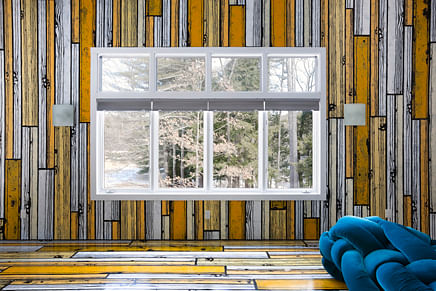
In Focus is Archinect's new series of features dedicated to profiling the photographers who help make the work of architects look that much better. What has attracted them to architecture? How do they work? What type of equipment do they use? What do they think about seeing their work in blogs?
In this feature, we talk to Brooklyn-based photographer Amy Barkow.
Archinect: What is your relationship with architecture? What drew you to architecture, as a photographer?
Amy Barkow: I was exposed to architecture from an early age because my brothers all worked construction throughout college, and eventually, three of them became successful in different aspects of the industry: architecture, general contracting and real estate development. However, it was my mother’s creative skills as a seamstress and weaver that led me to explore fine art as a career. I studied photography, video and sculpture at the Kansas City Institute of Art and Combined Media at Hunter College in New York City.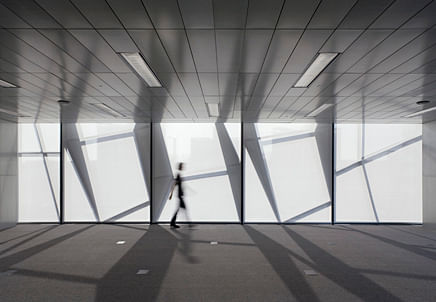
Office Building, Seoul - Barkow Leibinger Architects - Photography by Amy Barkow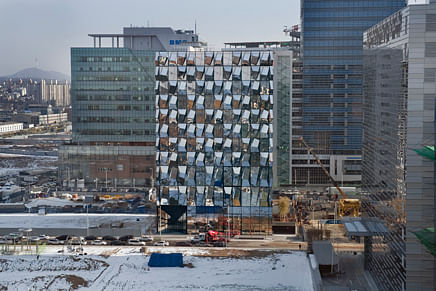
Office Building, Seoul - Barkow Leibinger Architects - Photography by Amy Barkow
In graduate school, I discovered German photographers Struth, Hofer and Ruff who were making art related to architectural photography; they followed the tradition of their professors Bernd and Hilla Becher who documented disappearing German industrial architecture. I was inspired by the creative potential of their approach. I became fascinated by how images of buildings can shape the way we understand them, specifically those we may have never visited. I was equally fascinated by images that outlive their subjects as with Kurt Schwitters’ Merzbau or where an image is all that ever existed of an influential building/project, like Mies’ plan for an Office Building for Friedrichstrasse or Tatlin’s Monument to the Third International.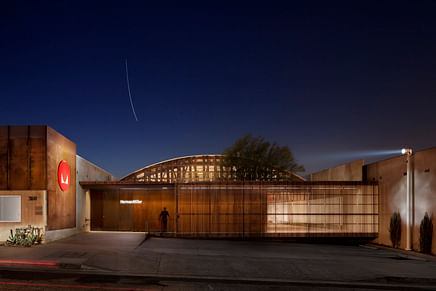
Herman Miller Building, Los Angeles - Lynch / Eisinger / Design - Photography by Amy Barkow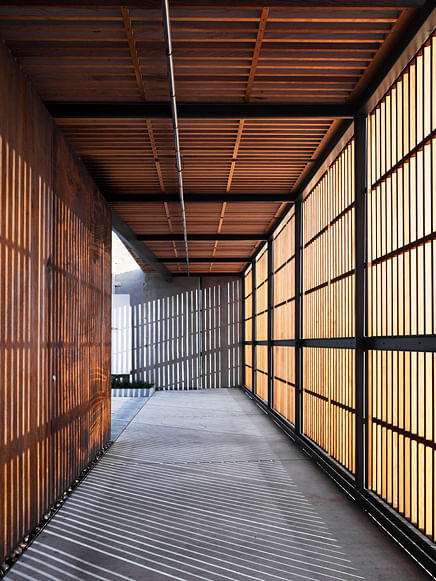
Herman Miller Building, Los Angeles - Lynch / Eisinger / Design - Photography by Amy Barkow
Describe how you work... who are your clients?
AB: When possible, I like to visit a project prior to the shoot, review drawings/plans and discuss the design intent with the architect in order to figure out the final shot selection. Although I started working in film, I now work primarily in digital; I use a digital camera with fixed lenses that is almost always tethered to a computer. I follow the light, (if there is daylight) which typically dictates the order of my shots. On night shots or on shots where artificial lighting is preferable, I like to order my shots as one might wander through the building or installation.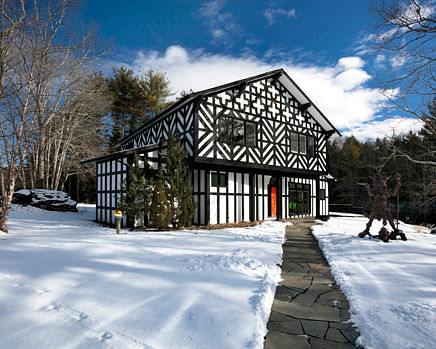
Private Residence, Woodstock, NY - Artist Richard Woods - Photography by Amy Barkow
Private Residence, Woodstock, NY - Artist Richard Woods - Photography by Amy Barkow
The majority of my clients are New York-based architects, interior designers, editors and publications. Living and working in New York City, I tend to get interior commissions. Nevertheless, I was recently commissioned by an art gallery to photograph colorful large-scale installations by the British artist Richard Woods at the Lever House and at a private residence in Woodstock, NY. I was also just commissioned by a large advertising firm to shoot a newly re-branded store for the world’s largest nutritional supplement company. I have also had the privilege to photograph my brother and sister-in-law’s stunning buildings in Europe and Asia.
Contemporary Art Museum, Denver - Adjaye Associates - Photography by Amy Barkow
Bond Street Spa, New York City - Lynch / Eisinger / Design - Photography by Amy Barkow
What is your goal when capturing buildings in photographs?
AB: Getting the shots that my clients want is a priority, but ideally, my images would capture the experience of physically discovering a building for the first time. I understand that an image cannot replicate the genuine experience, so I try to distill that experience into a handful of images, not to document it necessarily, but to expose something in a building that might not be so readily apparent. Surprises can be powerful.
What are your thoughts about including people in your photos? Is it important to photograph a building in use, or by itself?
AB: I think both are good to have; people add an element of scale and also help reveal the building’s intended use. While shooting an office building alone in Seoul Korea, I had to set the timer on my camera and run into the shot. I had to run several times to get it right; it was hilarious.
↑ Click image to enlarge
Cafeteria, Ditzingen - Barkow Leibinger Architects - Photography by Amy Barkow
↑ Click image to enlarge
Cafeteria, Ditzingen - Barkow Leibinger Architects - Photography by Amy Barkow
↑ Click image to enlarge
Cafeteria, Ditzingen - Barkow Leibinger Architects - Photography by Amy Barkow
↑ Click image to enlarge
Cafeteria, Ditzingen - Barkow Leibinger Architects - Photography by Amy Barkow
↑ Click image to enlarge
Lever House Installation, New York City - Artist Richard Woods - Photography by Amy Barkow
↑ Click image to enlarge
Lever House Installation, New York City - Artist Richard Woods - Photography by Amy Barkow
What are your favorite pieces of equipment?
AB: This is a tough question. Photo equipment and technology change so rapidly it’s difficult to get attached to any one piece. That being said, my favorite pieces of equipment are those that have been given to me. My friend JB gave me his Bogen tripod head, and my former employer Paul Warchol gave me his Sinar F2, a pro light, stands and more. These are the pieces I’ll never get rid of.
↑ Click image to enlarge
Residential Building, Denver - Studio Daniel Libeskind - Photography by Amy Barkow
↑ Click image to enlarge
Lake House, Connecticut - James Cleary Architect - Photography by Amy Barkow
↑ Click image to enlarge
Private Residence, New York City - Gregory Merryweather Architect - Photography by Amy Barkow
↑ Click image to enlarge
Private Residence, New York City - Gluckman Mayner Architects - Photography by Amy Barkow
↑ Click image to enlarge
Private Residence, New York City - Gluckman Mayner Architects - Photography by Amy Barkow
↑ Click image to enlarge
Charter School, Bronx - Peter Gluck and Partners Architects - Photography by Amy Barkow
Do you work alone?
AB: I work alone and I work with assistants depending on the scope, budget and complexity of the project. That being said, working alone can be rewarding as it allows for unexpected discoveries; some of my favorite shots happen when I’m alone on a shoot. Time and circumstance don’t always allow me the luxury of shooting alone, and in these instances, I am fortunate to be able to work with dedicated and talented assistants.
↑ Click image to enlarge
Office, New York City - Murphy and Dine Architects - Photography by Amy Barkow
↑ Click image to enlarge
NYU School of Medicine, New York City - Mitchell Giurgola Architects - Photography by Amy Barkow
↑ Click image to enlarge
Private Residence, New York City - Celeste Umpierre Architect - Photography by Amy Barkow
↑ Click image to enlarge
Private Residence, New York City - Fiedler Marciano - Photography by Amy Barkow
How do you feel about seeing your photographs on blogs and websites?
AB: I suppose that is the point; it would be a shame for my work and the work of my clients to sit on a hard drive. On the other hand, architectural photography is one of the lowest paid in the field of photography. Usage fees from publications are a way for architectural photographers to keep rates low for clients who don’t have big budgets. All of this seems to be changing with the current economic climate where there are fewer publications and of those many are less willing or able to pay for images. At the very least I ask that I am properly credited and where possible, provided a link to my website.
↑ Click image to enlarge
Art Museum, Denver - Studio Daniel Libeskind - Photography by Amy Barkow
↑ Click image to enlarge
Art Museum, Denver - Studio Daniel Libeskind - Photography by Amy Barkow
↑ Click image to enlarge
Biennale Architecture Installation, Venice - Barkow Leibinger Architects - Photography by Amy Barkow
↑ Click image to enlarge
Art Museum, Denver - Gio Ponti - Photography by Amy Barkow
Amy Barkow was born in Great Falls, Montana. After completing her MFA from Hunter College in 2002, she had her first Solo exhibition at New Jersey City University. She has worked in New York City as an architectural photographer since 2000, an occupation that has influenced her art. Her work has been exhibited worldwide and She has received support from The University of Illinois at Urbana-Champlain, The Santa Fe Art Institute, Times Square Alliance, The Lodz Artists Museum, American Institute of Architects and Golden Seed, India. Amy has been a visiting critic at SUNY New Paltz, New Jersey City University, and the Montana State University School of Architecture, and worked as an art educator for the Joan Mitchell Foundation.
A series of Amy’s photographs were exhibited in Branded and on Display, a traveling group exhibition opening at the Krannert Art Museum at the University of Illinois at Urbana-Champlain; the Krannert Art Museum purchased two of the works for their permanent collection. Recently she gave a lecture on architectural photography at Cornell University with colleague John Bartelstone. Amy lives and works in New York City.
3 Comments
Amazing photos! I am really impressed by the cinematic quality of Amy's work and how she is able to capture motion or implied motion such as in her shot of the Herman Miller Building. I am also particularly drawn to Amy's shots of otherwise static spaces such as the classroom and bicycle room.
AMY,
WONDERFUL PHOTOGRAPHS !
BEAUTIFUL LIGHT.
BEST WISHES, JON D'ORAZIO
I am struck by the purity and innocence.
Of not just the light
The composition?
Theres something more
Something spiritual
That draws something from deep inside of me.
Bravo!!
Block this user
Are you sure you want to block this user and hide all related comments throughout the site?
Archinect
This is your first comment on Archinect. Your comment will be visible once approved.